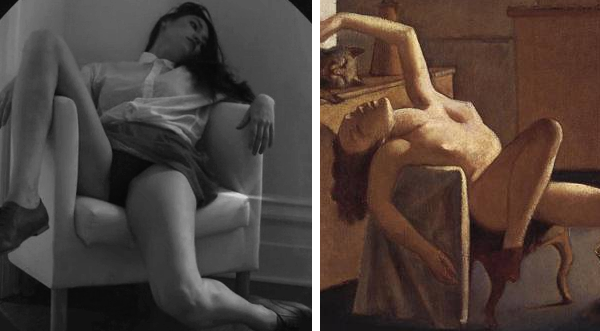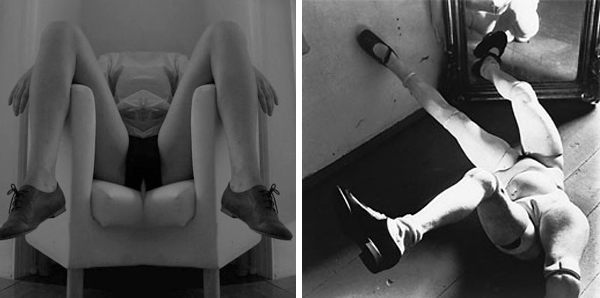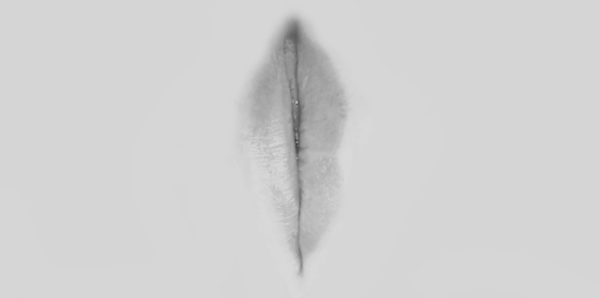Film
A short film by Ellen Frances

Ellen Frances, director and subject of her short film “Very Beautiful Woman” (2011, Pangur Ban Party) may well be aware of the evocative poses from which hers are derived, or not. Balthus (1908 -2001) has been criticized much for his erotic depictions of underage girls, often struggling in compromised and subordinate positions. Men may offer other men more to look at, but it takes a women to turn it into something formidable. I had to increase the RGB input level in the pic — to fill that room with light, virtually, miles away — to confirm that the dark patch between her legs were indeed panties and not the unkempt bounty of a more natural sort. I only speak so glibly in faith that my inclinations are at first respectful. Frances frames herself inside a cosmetic blush mirror, at first held in her hands, then in what is made to appear as a larger mounted wall mirror — the repeating circular motif functioning as a distancing viewfinder of some sort, lending a layer of documentary mediation and self-cognizance. With Cindy Sherman, Vanessa Beecroft [‘s subjects], and perhaps Miranda July, Frances stands in the company of women who have found ways to negotiate the expectations of their bodies without looking away.

The occasional De Beers diamond ring ad sentimentally is fortunately stricken with the onset of the surreal and uncanny. We’ve all toyed with Mac’s photo booth “mirror” effect, in which subjects are graced with perfect symmetry, only to be giddily made into animals. Frances seems aware of this, though she distances herself from the casualness of the “incidental moment” caught by so many young women whose affectations in front of laptop video cams are no less calculated and aestheticized. Hans Bellmer (1902 – 1975), who did not survive Balthus, was also captivated by pre-pubescent somewhat violated girls, modeling life-sized sexualized effigies into the deformed and grotesque. He was one of the first artists whose creations were a means to the greater conceptual art of its documentation, the photography of it. (Jeff Wall seems to be the most advanced and contemporary example of this.) Again, Frances may have flapped through a handful of art history books, or she is that intuitive; or perhaps, it is I whose enduring existence seems more and more merely in aid of commemorating all the images ever to have struck me, the life of art greater than the life it ostensibly honors.
What is both subtly apparent and striking is how the tripod seems to be the only camera man present. The shots are all still, and seemingly edited into cinematic cadence later. I imagine Frances walking over to the camera to stop the blinking red eye, and likewise, walking away from it into its very foci. Such solipsism or autonomy has a tinge of narcissism, and a little bit of endearing loneliness, but ultimately, it is empowering — that someone could create such a highly evolved version of themselves in the very apartment they live in, alone, perhaps on their day off, or off(s), the minutiae of every corner, every wall, every floor board, every angle explored and disembodied from the prosaic daily moments of cell phone chargers, grocery bags, and electric bills.

May this be a collaboration I suppose, as I “helped” this image in photoshop for purposes of this post — but please, it was not I who turned her lips 90° clockwise into a such labia-like orientation. Frances clearly understood the anatomical implications of jutting out her tongue in the same place a clitoris would be, a kind of projected auto-cunnilingus as self-affirming act. I also recall a farce on Vintage’s 50th anniversary edition of Lolita where the lips were also rotated into lips of a less talkative gushy sort — and I admit it’s probably just me reading into Nabokov’s famous “tip of my tongue” opening sequence. Oddly, or incidentally, perhaps inextricably, one of Penguin’s edition of that book featured Balthus’s “Girl with a Cat” (1937), whose subject’s pose was similar in recline to the one referenced above. When a man does it, it’s misogyny; when a woman does it, it’s feminism. Of course, this reductive binary reasoning is boring, and cheats Frances out of her intentions.
As for the cosmetic blush mirror we first see her composed in, it might be a portal for commercialized gender construct and expectation. The circle, however, gets bigger and bigger, until it is the full moon. She ends with her naked back to us, dissolved into the ever smiling lunar face, the ebb and flow of waves in my tiny speakers foaming at the sand. It takes confidence to appoint oneself the subject of a film called “Very Beautiful Woman,” a confidence we shall grant her. Here is a woman from the internet with a camera who is doing far more than simply gazing into it.
[View.]
Tags: Ellen Frances

The bottom picture makes me think of the origins of painting a woman’s lips so they resemble her actual vulva. What a beautiful little film.
spooky
[…] comment sent me back to watch both again, as well as search for the post that Jimmy Chen wrote about Very Beautiful Woman. He noticed “a repeating circular motif” that “functions as a […]